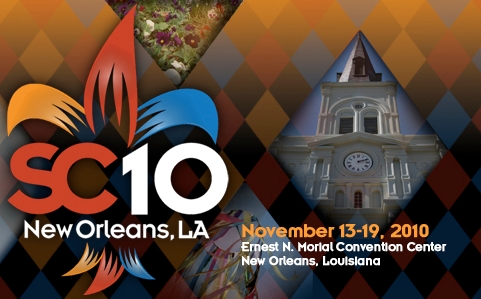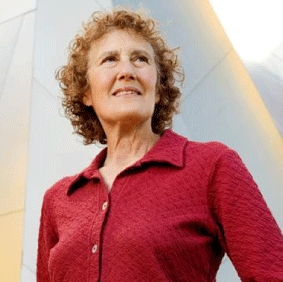XRDS: News Archive 2010
Call for Women of Vision Award Nominations
November 18, 2010—Nominations are now being accepted for the 2011 Women of Vision Awards, sponsored by the Anita Borg Institute for Women and Technology (ABI), honoring women who make significant contributions in three areas:
- innovation
- social impact
- and leadership.
Nominations are now being accepted online, with a deadline of
December 10, 2010. The winners will receive their awards at a ceremony
in California next May.
The innovation category recognizes a woman who has contributed
significantly to technology innovation, whether it be creating unusual
and important technologies or approaching developing technology in a
significantly new and innovative way, such as by bringing diverse people
and experiences together in the technology creation process.
The
social impact category recognizes a woman who has developed or applied
technology with a significant impact on society or the community,
someone who is creating or employing technologies that are changing our
world in positive ways.
The leadership category recognizes a
woman who has led an important technology development or innovation,
made a significant contribution to the technology industry, and has
inspires others.
In addition to these three awards, a fourth
award, the Anita Borg Top Company for Technical Women, will also be
presented at this year’s Women of Vision Awards in May in Santa Clara,
Calif. The Top Company Award recognizes an organization that has
demonstrated measurable results in the recruitment, retention, and
advancement of technical women at all levels. Nominations have already
closed for this category.
Students prepare for Sc10 competition
October 21, 2010—Next month a real-time, 46-hour non-stop competition will consume students from around the world.
The event, the 2010 Student Cluster Competition, is set to take place during an international conference on high performance computing, networking, storage and analysis, to be held Nov. 13-19 in New Orleans, Louisiana.

The competition will feature eight teams of undergraduate students building, tuning and racing high-performance computing (HPC) clusters of their own design on the conference's showfloor. The teams will race against each other and the clock to run the greatest number of applications. An added catch is that teams will be required to run workloads on the same power needed to run only three coffeemakers. Now in its fourth year, the Student Cluster Competition serves to showcase young computing talent and foster HPC education development.
“By showcasing some of the best young talent in HPC at SC10, the cluster challenge is a win for students, the institutions they represent, sponsors and cluster computing itself,” said Tiki Suarez?Brown, co?chair of this year’s competition, “The competition also demonstrates that cluster computing is making HPC more accessible to smaller companies, businesses and educational institutions.”
In the lead-up to the big day, the competing teams are currently perfecting designs and preparing to build cutting?edge clusters from commercially-available components. After the starting gun at SC10, teams will compete to achieve the best HPC benchmark performance and maximum throughput of accurate applications runs, all while remaining at or below their 26 amp energy budget.
Participating students range from National Tsing Hua University (Hsinchu, Taiwan), Nizhni Novgorod State University (Nizhni Novgorod, Russia), Florida A&M University, University of Colorado, Purdue University, and more.
Last year, a team from Stony Brook University, New York, won the SC09 Student Cluster Competition, sponsored by AMD, Dell and Mellanox Technologies.
The Student Cluster Competition (SCC) is organized collaboratively by the SC10 Technical and Communities Programs to foster HPC education development by providing an intense hands-on experience to high school and undergraduate students throughout the year. The SCC is only partially funded by the SC conference.
Also of interest to students, SC10 will host a student job fair.
SC10 will be held in the Ernest N. Morial Convention Center, New Orleans, Louisiana, November 13?19, 2010. For more information, see http://sc10.supercomputing.org/.
ACM Seeks Best PhD Works, honored with $20,000 Prize
October Deadline Approaching for 2010 Nominations
September 2010 – Last year, PhD student Craig Gentry of Stanford University, won $20,000 for his doctoral dissertation “A Fully Homomorphic Encryption Scheme.” Gentry’s was recognized for his work on advanced encryption technology by the ACM’s Doctoral Dissertation Award.
This year, nominations are open once again for the prestigious award, with a deadline of October 31.
According to the award web site,
nominations for the Doctoral Dissertation Award are limited to one per
university or college, from any country (unless more than ten PhDs are
granted in one year, in which case two may be nominated). All nominated
works must have been accepted by the department between September 30,
2009 and September 30, 2010.
To be nominated, the doctoral student
must have his or her thesis advisor submit the work to ACM, and the
nomination must be endorsed by the head of the department. All
submissions should include a one-page summary of the significance of
the paper written by the advisor.
The Dissertation Award is part of a larger series of awards given by the ACM, which also includes
- the Grace Murray Hopper Award, recognizing one young computer professional of the year, selected on the basis of a single recent major technical or service contribution made before the age of 35
- the ACM-W Athena Lecturer Award, which celebrates women researchers who have made fundamental contributions to computer science (nominations can only be made by ACM SIG officers)
- the Karl V. Karlstrom Outstanding Educator Award, honoring educators who advance new teaching methodologies or curriculum development in computer science and engineering.
Many of these awards, including the Doctoral Dissertation Award and ACM-Infosys Foundation Award in Computing Sciences have deadlines that are fast approaching.
See the official ACM Awards nomination page
for complete details regarding the nomination process and additional
details about the 2010 Award Subcommittee Chairs and Members. —Shawn Freeman
NSF Calls for Proposals to Get More Women in Faculty Positions
August 11, 2010 — Got
any ideas for how to get more women teaching science, technology,
engineering, and math (STEM) at the collegiate level? The National
Science Foundation is looking for some help.
Got
any ideas for how to get more women teaching science, technology,
engineering, and math (STEM) at the collegiate level? The National
Science Foundation is looking for some help.
The NSF this week announced a call for proposals to attract and advance more female faculty members in the STEM fields. The program is called ADVANCE: Increasing the Participation and Advancement of Women in Academic Science and Engineering Careers.
According to the NSF,
the goal of the program "is to develop systemic approaches to increase
the representation and advancement of women in academic STEM careers,
thereby contributing to the development of a more diverse science and
engineering workforce. ADVANCE focuses on ensuring that women faculty
with earned STEM degrees consider academia as a viable and attractive
career option." However, the NSF is specifically not looking for ways
to increase the number of female PhD candidates. Rather, the focus is
on what comes after that phase. Additionally, proposals that address
issues of attracting more women from underrepresented backgrounds and
increasing international collaboration will be favored.
The deadline to
submit a letter of intent is October 4, 2010, and the deadline for full
proposals is November 8, 2010. The program will continue in 2011 as
well, with new submission dates of October 3, 2011, and November 7,
2011.
To participate or learn more in about women in computing specifically, visit ACM-W,
the Association for Computing Machinery's special group for
celebrating, informing, and supporting women in computing. The image
shown is Barbara Liskov, the 2008 ACM A.M. Turing Award winner, one of several women of distinction in computing highlighted on ACM's site.
Human computation in Archaeology
July 11, 2010 —
It's not uncommon to ask for public assistance in finding missing
persons; however, it's not everyday that the public is asked to
assist in finding an 800-year old missing tomb. The lost tomb
of Genghis Khan is believed to be located in the Valley of the
Khans, Mongolia, but the size of this sacred region, as well as local
traditions prohibiting its disturbance, call for unconventional search
methods.
Dr. Albert Lin of UC San Diego and his team apply
non-invasive search methods to identify archaeological sites without
disturbing them. Their approach includes detailed analysis of
high-resolution satellite imagery, or in other words, combing through
thousands of square miles of satellite images in search of clues to the
tomb's location. This is clearly more than any single individual or
team could ever handle. Surprisingly, it's also more than a computer
can handle, as computers currently lack the visual perception required
to find telltale anomalies in the photos.
That's where you, with your amazing human visual perception, can help out. National Geographic has recently released a Human Computation website,
where volunteers can look through photos and tag suspicious locations.
These tags will help guide the explorations of an expedition to
Mongolia led by Dr. Lin over the month of July.

For more details check out the expedition's website.
And to learn more about the exciting area of Human Computation and
Crowdsourcing, stay tuned for the upcoming Winter 2010 (December) issue
of XRDS.
Programming 'Boot Camp' Offers Basic Training
By Marina Krakovsky (ACM News and CACM.acm.org)
June 15, 2010 — John Stamey 's breakthrough came during a moment of frustration. Several years ago, the Coastal Carolina University computer science professor was teaching second-semester students who, to his amazement, still couldn't so much as write a loop. So he ditched his syllabus and started from scratch. "I said, 'We're just going to do a boot camp. You have two weeks to write these 100 programs.'"
The drill-sergeant strategy worked: by term's end, Stamey says, "the level of programming went from nowhere to everywhere."
Since then he's taken the approach to the greenest recruits: CS majors taking his department's most elementary programming class, which uses Python to ease students into the key components of structured programming: statements in sequence, loops, and IF statements. Despite these modest learning goals, only 76 percent had typically finished with a C or better — but in the first boot camp, the pass rate jumped to 95 percent, with most students earning an A or B.
In contrast to the old curriculum, which assigned three to four programs per semester, the new course has each student write 370 very short programs. A typical program from midway through the boot camp prints the multiples of 10 from 200 to 400, one per line, or asks the user to input two numbers and print their sum and product. "It may get repetitive, but I'll tell you what: you'll learn," Stamey says.
The idea of teaching through hundreds of short programs isn't new. Northeastern University CS professor Matthias Felleisen , an ACM Fellow and winner of the 2009 Karl V. Karlstrom Outstanding Educator Award , has been doing it for about 18 years and popularized it in "The Little Schemer" (MIT Press, 1995). But the approach was a revelation for Stamey, who was excited enough by the results to present them at a conference and publish his own book, "Computer Science Boot Camp" (John W. Stamey, Jr., 2009).
Not everyone's impressed. Shriram Krishnamurthi , a computer scientist at Brown University who also teaches programming to middle-school and high-school students, questions the emphasis on particular programming constructs instead of more generalizable skills. "The student has not been given a way to do programming — they've learned the constructs of one programming language," he says. "What happens when the students go on from this to other courses?"
Some hit a wall. Stamey later found that although performance in the second-semester course did improve after students had taken the first-semester boot camp (compared to students who'd followed the old curriculum), the difference was less dramatic than in the first boot camp—a result Stamey attributes in part to the second-semester switch from C++ to C, which he says is a tougher language. But he remains confident the boot camp is good for his students, many of whom are drawn to Coastal Carolina for its low tuition and nearness to Myrtle Beach. "For students who don't have the best math skills when they come in, I think for some of them it helps."
Mathematicians Solve 140-Year-Old Boltzmann Equation
University of Pennsylvania
May 18, 2010—Two University of Pennsylvania mathematicians have found solutions to a 140-year-old, 7-dimensional equation that were not known to exist for more than a century despite its widespread use in modeling the behavior of gases.The study, part historical journey but mostly mathematical proof, was conducted by Philip T. Gressman and Robert M. Strain of Penn's Department of Mathematics, Philadelphia, PA.
The solution of the Boltzmann equation problem was published in the Proceedings of the National Academy of Sciences. Solutions of this equation, beyond current computational capabilities, describe the location of gas molecules probabilistically and predict the likelihood that a molecule will reside at any particular location and have a particular momentum at any given time in the future.
During the late 1860s and 1870s, physicists James Clerk Maxwell and Ludwig Boltzmann developed this equation to predict how gaseous material distributes itself in space and how it responds to changes in things like temperature, pressure or velocity. The equation maintains a significant place in history because it modeled gaseous behavior well, and the predictions it led to were backed up by experimentation.
Despite its notable leap of faith—the assumption that gases are made of molecules, a theory yet to achieve public acceptance at the time—it was fully adopted. It provided important predictions, the most fundamental and intuitively natural of which was that gases naturally settle to an equilibrium state when they are not subject to any sort of external influence. One of the most important physical insights of the equation is that even when a gas appears to be macroscopically at rest, there is a frenzy of molecular activity in the form of collisions. While these collisions cannot be observed, they account for gas temperature.
The study was funded by the U.S. National Science Foundation.
ICPC Update
May 2010—The most recent World Finals for the ACM International Collegiate Programming Contest (ICPC) were held earlier this year in Harbin, China, and were hosted bu Harbin Engineering University.
The top team in 2010 was Shanghai Jiaotong University, which took home its third world title, with 7 of 11 problems solved.
Other gold medalists in the event were Moscow State University, National Taiwan University, and Taras Shevchenko Kiev National University.
The ACM International Collegiate Programming Contest (ICPC) is a multitier, team-based, programming competition operating under the auspices of ACM and headquartered at Baylor University. The contest involves a global network of universities hosting regional competitions that advance teams to the ACM-ICPC World Finals. Participation has grown to several tens of thousands of the finest students and faculty in computing disciplines at almost 2,000 universities from more than 80 countries on six continents. The contest fosters creativity, teamwork, and innovation in building new software programs, and enables students to test their ability to perform under pressure. Quite simply, it is the oldest, largest, and most prestigious programming contest in the world. The 2010 World Finals were sponsored by IBM.
For current news content, visit here.


